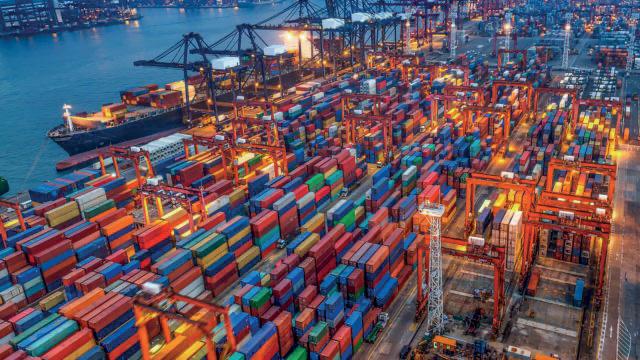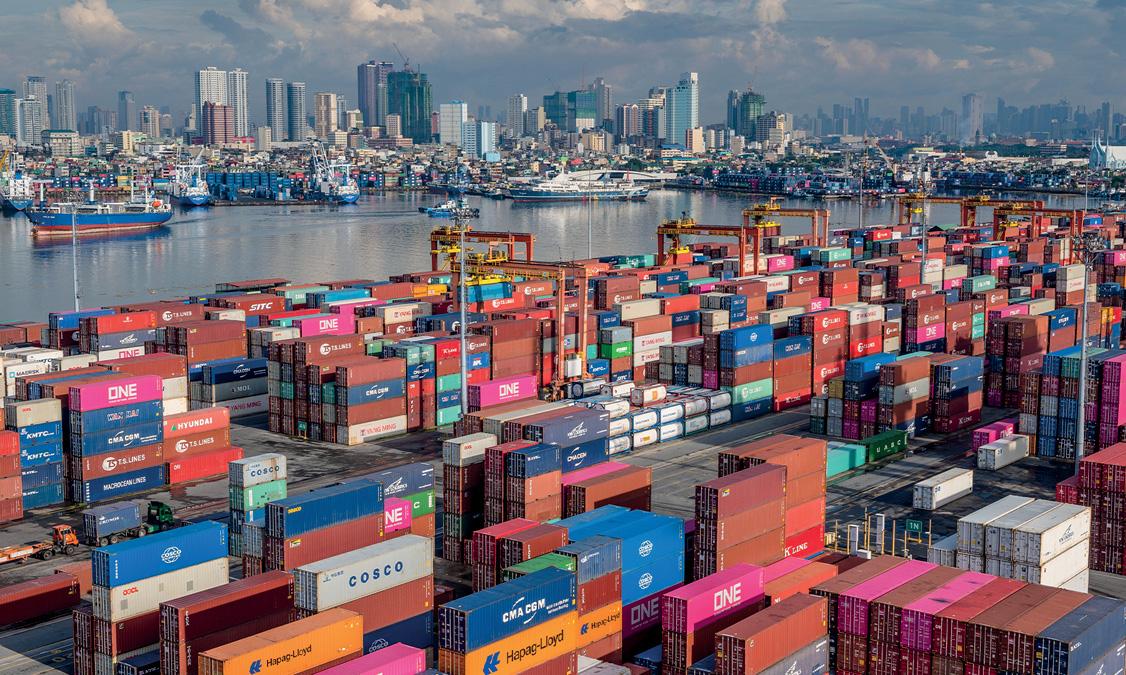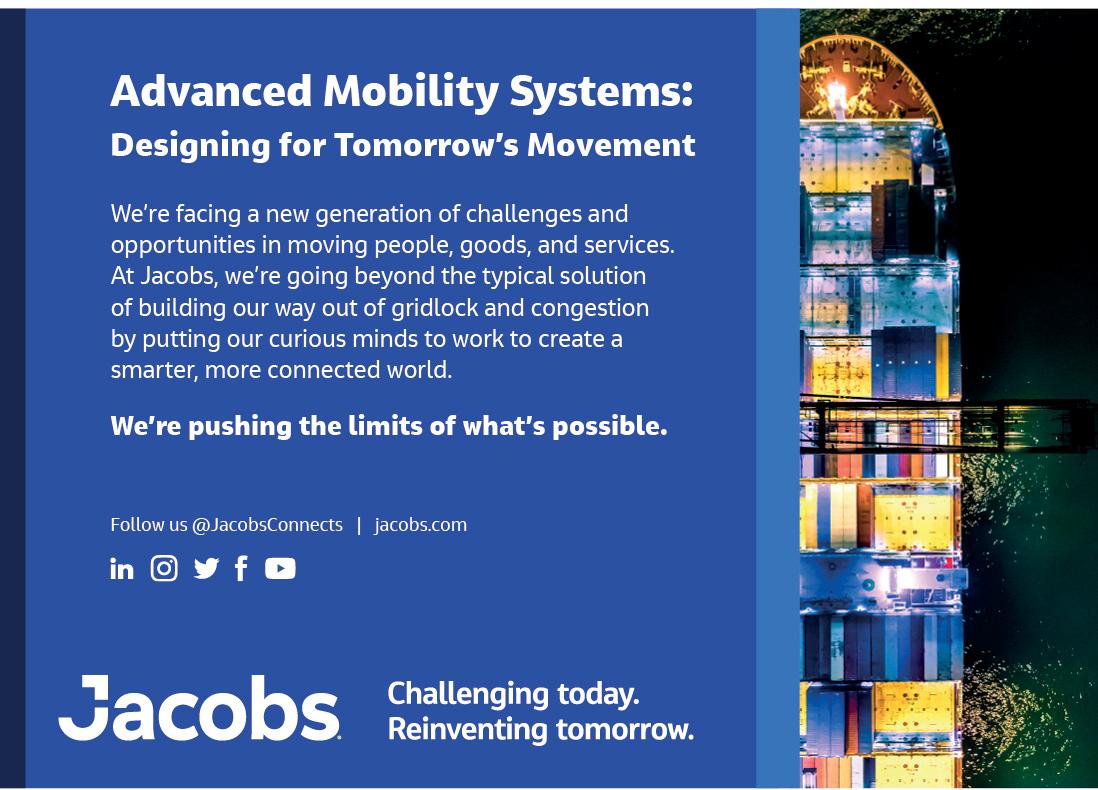
7 minute read
Who Dares Wins
In its own right or in a ‘joined up way” modern technology holds the power to enhance key front-line and back-up terminal activities. Felicity Landon highlights current initiatives
Sometimes, in order to add value, you must fi rst disrupt. This was the opening message from Jon Arnup, founder of the Singapore-based Trent Ports Group, as he led the presentations at a webinar focusing on “Unleashing the potential of innovative solutions and advanced AI driven technologies”.
The headline name for the Transport Events webinar was actually “Who Dares Wins” – and in the current digitalisation frenzy, it would be easy to imagine ports rushing to digitalise anything that moves in order to leave competitors in their wake.
However, there were comforting words of caution from Arnup. “The digital transformation that we strive for must be phased in its delivery, or able to be phased, be aligned with cost and the revenue profile of each terminal and be aligned to the risk appetite of a port,” he said.
Five partners that have teamed up with each other to deliver end-to-end solutions for ports in AI, technology and digital solutions – Trent, Jacobs, IGO Solutions, Aidrivers and Remy InfoSource – each presented new innovations at the webinar.
While some ports “have embraced the Who Dares Wins with some success”, said Arnup, “we understand that big bang is not a reality for many ports today and we believe that that is preventing some terminals from taking those early steps towards a joined-up holistic digital autonomous transformation. It is important that we see the strategic business goals and vision of your terminal and carefully align with those.”
He outlined two specific solutions – Trent Moscord, described as ‘the Amazon of ports’, and Multistaka, a highrise container concept.
Trent Moscord is a dedicated spare parts catalogue “for each and every crane, piece of equipment, type, model, in your terminal”, said Arnup.
The system provides the purchaser with three live quotes and enables 90 per cent faster procurement cycles which mean “you can do more with less, it eliminates delivery errors and there is no more guesswork when identifying a spare part, he said. “Also, there is increased visibility, and competition is driving down prices where needed.” He predicted increased negotiating power as more terminals join the platform and said terminals could save hundreds of thousands of dollars as a result.
INTEGRATING SOLUTIONS
Aldo Ferrufino, Port Solutions Director at Jacobs in the UAE, discussed the challenge of integrating solutions. As far as the concept of the ‘big bang’ was concerned, terminal operators’ key concerns were the cost and understanding what they have to do with all the digital elements, he stated.
“The market is flooded with fragmented standalone offerings where in themselves each one has its own merit – but how do you pull all that together to make sure you are squeezing the actual value they have?”
Ever-changing conditions call for solutions that are flexible and adaptable, and the market needs focus on business and technical solutions that are sustainable, resilient and adaptable, he added. There is also an increased need for customisation.
He explained the five partners’ involvement in end-to-end (E2E) Solutions, to integrate port technology and develop solutions, whether for a new development or expansion of operations, with solutions grouped into three areas – business, intelligent port, and technical.
Traditionally people look at masterplans as a civil engineering exercise but that is not correct, he said. “By harnessing and utilising digital twins and, for example, the projections of operations, we can work out a masterplan which is aligned with your actual business needs, not aligned with the civil engineering of it.”
8 Projects
undertaken by Trent Ports Group include the introduction of a highly focused asset management programme for a Middle East based terminal operator
Sometimes, in order to add value, you must first disrupt‘‘ Jon Arnup, Founder, Trent Ports Group, Singapore
Finetuning in the early stages will save money later in the lifecycle of an asset, as well as delivering efficiency and mitigating risk, said Ferrufino.
“It is having that visibility and understanding of what it is that you can do with what you have – and it doesn’t necessarily have to be expensive.”
From AI systems enabling predictive maintenance to automation or electrification, positive disruption can continue using “technical interrelationships” across all port applications, he said.
Efficiency and being able to move the containers is where digital comes into play, he concluded: “You can enhance the infrastructure but the operation is what stays in the longer term.”
AI: LEARNING EVERY DAY
We are learning every day about the possibilities of AI, said Jay Pandya, Director of IGO Solutions, who warned: “We need to adapt – if we don’t, we lose money and in radical situations we may not even exist.”
AI brings together uncertainties versus optimisation, said Pandya. He outlined the implementation of three-step autonomous industrialisation in ports and explained the need for ‘cleansing’ data.
“A practical example – we worked with a very large yard in Asia which had high yard utilisation but uneven RTG workload distribution, a high rehandle count and lower productive moves.”
After a few weeks of operations, comparing the newly AIoptimised berth with a non-AI berth, there was a 15% improvement at the AI berth, with all the RTGs doing more productive work, and doing their work consistently, and a reduction in rehandles per container.
“Confidence in the operations team has really grown and we are working day to day with them to ensure where AI is going and how it can deliver results and allow them to focus on the decisions that really matter – and that is a real shift that we find.” The AI solution is now being rolled out across the whole terminal, he added.
Port operators are working towards providing service predictability and that is what Aidrivers has been focusing on, said Rafiq Swash, founder and CEO of Aidrivers.
“The need is for self-aware operations, for resilience, efficiency and much better predictability. The challenge is optimisation of the operations to improve productivity and reduce operational costs.”
Rather than waiting for new vehicles or infrastructure upgrades, Aidrivers is focusing on existing fleets and making automation more accessible, adapting manual vehicles to become driveable by machine, said Swash.
“We upgrade with our autonomous intelligent retrofitting system with drive-by-wire manager for precision drive control system with failsafe mechanism.”
The system includes precision 3D mapping and localisation, AI-enabled perception with situation cognisance and responsive autonomous drive. However, success depends on a ‘self-aware’ operation, connecting not just the vehicle being autonomously driven, but also other vehicles and equipment, including traffic lights and trucking stations, for example, said Swash.
Also, it is crucial that existing ports operations are not interrupted or stopped, he said. Aidrivers uses a digital twin to replicate a terminal with full accessibility of operations, enabling it to test and optimise a system without disturbing existing operations.

8 ICTSI’s fl agship
Manila International Container Terminal (MICT) in the Philippines has implemented IGO/ Avlino’s YardSight AI from the AiCON suite for its RTG operation
Outlining the iSpec system for project management, tendering and delivery, Pieter Boshoff, CEO of Remy InfoSource, said the first priority was clear: “We need a single point of truth somewhere in the cloud, so it doesn’t matter which phase of the project you are in – whether developing, putting out to tender or monitoring delivery, there should only be one data source and a single point of truth for all stakeholders, so you never have outdated information on anyone’s PC.”
Through a ‘master library’ of standards and the creation of standards for certain types of projects, iSpec ensures only the correct version of a specific project is ever available, he explained.
He described the system as “a seamless, fully integrated, collaborative process from concept to final handover, with a comprehensive, contextual audit trail allowing full transparency.
“We all know the problems – delays, delivery of incorrect equipment, mistakes in design. We often found people sent out the wrong specs to the vendors or [were] making unauthorised changes. The other thing was speed – sending documents back and forth wastes a lot of time, and versions get mixed up.
“When managing a large project, thousands of emails and attachments go back and forth, he said. “How do I ensure I can get the one I need six months into a project?” iSpec allows for online collaboration, with eligible people able to edit concurrently and approve documents in the cloud – this means people in different locations can work on the spec at the same time and see each other’s changes. Certain standards or sections can be locked and therefore not be changed.
“All stakeholders can start work on the documents concurrently – if someone starts preparing a tender and specs, by the time they are halfway, someone can start checking at the top. All edits are stored in a permanent audit trail and with compare and rollback functionality.”
Use of the iSpec system has reduced ambiguity, amendments and disputes,” underlines Boshoff. “The audit trail contains every email, clarification, amendment, negotiation, allowing full transparency for easier dispute resolution.”












